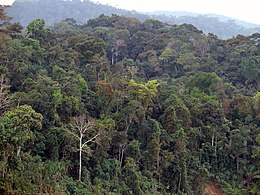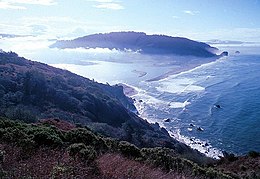
Back Biomasa (ecolochía) AN كتلة بيولوجية (علم البيئة) Arabic Biomassa (ecologia) Catalan Biomasse (Ökologie) German Biomaso (ekologio) Esperanto Biomasa (ecología) Spanish Biomass Estonian زیستتوده (بومشناسی) Persian Biomasse (écologie) French Bithmhais (éiceolaíocht) Irish
Biomass is the mass of living biological organisms in a given area or ecosystem at a given time. Biomass can refer to species biomass, which is the mass of one or more species, or to community biomass, which is the mass of all species in the community. It can include microorganisms, plants or animals.[3] The mass can be expressed as the average mass per unit area, or as the total mass in the community.
How biomass is measured depends on why it is being measured. Sometimes, the biomass is regarded as the natural mass of organisms in situ, just as they are. For example, in a salmon fishery, the salmon biomass might be regarded as the total wet weight the salmon would have if they were taken out of the water. In other contexts, biomass can be measured in terms of the dried organic mass, so perhaps only 30% of the actual weight might count, the rest being water. For other purposes, only biological tissues count, and teeth, bones and shells are excluded. In some applications, biomass is measured as the mass of organically bound carbon (C) that is present.
In 2018, Bar-On et al. estimated the total live biomass on Earth at about 550 billion (5.5×1011) tonnes C,[1] most of it in plants. In 1998 Field et.al. estimated the total annual net primary production of biomass at just over 100 billion tonnes C/yr.[4] The total live biomass of bacteria was once thought to be about the same as plants,[5] but recent studies suggest it is significantly less.[1][6][7][8][9] The total number of DNA base pairs on Earth, as a possible approximation of global biodiversity, is estimated at (5.3±3.6)×1037, and weighs 50 billion tonnes.[10][11] Anthropogenic mass (human-made material) is expected to exceed all living biomass on earth at around the year 2020.[12]
- ^ a b c Bar-On YM, Phillips R, Milo R (June 2018). "The biomass distribution on Earth". Proceedings of the National Academy of Sciences of the United States of America. 115 (25): 6506–6511. Bibcode:2018PNAS..115.6506B. doi:10.1073/pnas.1711842115. PMC 6016768. PMID 29784790.
- ^ Cite error: The named reference
ecologywas invoked but never defined (see the help page). - ^ IUPAC, Compendium of Chemical Terminology, 2nd ed. (the "Gold Book") (1997). Online corrected version: (2006–) "biomass". doi:10.1351/goldbook.B00660
- ^ Cite error: The named reference
Behrenfeldwas invoked but never defined (see the help page). - ^ Whitman WB, Coleman DC, Wiebe WJ (June 1998). "Prokaryotes: the unseen majority" (PDF). Proceedings of the National Academy of Sciences of the United States of America. 95 (12): 6578–83. Bibcode:1998PNAS...95.6578W. doi:10.1073/pnas.95.12.6578. PMC 33863. PMID 9618454.
- ^ Kallmeyer J, Pockalny R, Adhikari RR, Smith DC, D'Hondt S (October 2012). "Global distribution of microbial abundance and biomass in subseafloor sediment". Proceedings of the National Academy of Sciences of the United States of America. 109 (40): 16213–6. Bibcode:2012PNAS..10916213K. doi:10.1073/pnas.1203849109. PMC 3479597. PMID 22927371.
- ^ Deep Carbon Observatory (10 December 2018). "Life in deep Earth totals 15 to 23 billion tons of carbon -- hundreds of times more than humans - Deep Carbon Observatory collaborators, exploring the 'Galapagos of the deep,' add to what's known, unknown, and unknowable about Earth's most pristine ecosystem". EurekAlert!. Retrieved 11 December 2018.
- ^ Dockrill, Peter (11 December 2018). "Scientists Reveal a Massive Biosphere of Life Hidden Under Earth's Surface". Science Alert. Retrieved 11 December 2018.
- ^ Gabbatiss, Josh (11 December 2018). "Massive 'deep life' study reveals billions of tonnes of microbes living far beneath Earth's surface". The Independent. Retrieved 11 December 2018.
- ^ Landenmark HK, Forgan DH, Cockell CS (June 2015). "An Estimate of the Total DNA in the Biosphere". PLOS Biology. 13 (6): e1002168. doi:10.1371/journal.pbio.1002168. PMC 4466264. PMID 26066900.
- ^ Nuwer R (18 July 2015). "Counting All the DNA on Earth". The New York Times. New York. ISSN 0362-4331. Retrieved 18 July 2015.
- ^ Elhacham, Emily; Ben-Uri, Liad; et al. (2020). "Global human-made mass exceeds all living biomass". Nature. 588 (7838): 442–444. Bibcode:2020Natur.588..442E. doi:10.1038/s41586-020-3010-5. PMID 33299177. S2CID 228077506.

